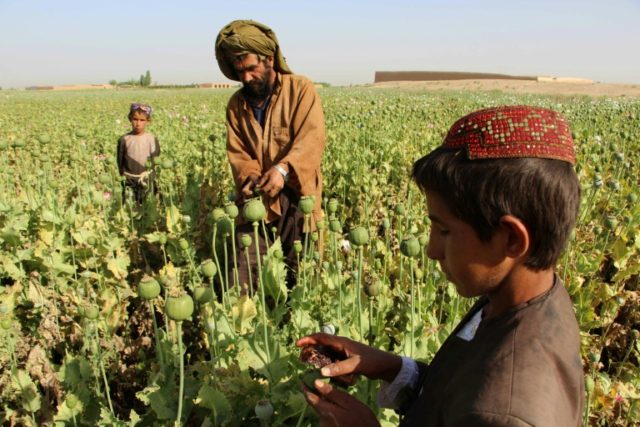More than a quarter of the opium poppies grown in Afghanistan last year came from districts controlled or influenced by the Afghan government, the U.S. Special Inspector General for Afghanistan Reconstruction (SIGAR), a watchdog agency, reported Thursday.
Of the more than $132 billion in U.S. taxpayer funds invested in nation-building efforts since the war started in October 2001, the American government has reportedly devoted nearly $9 billion on counternarcotics operations in Afghanistan.
The country remains the world’s top producer of opium, the main ingredient in heroin. Some Afghan heroin is fueling the overdose epidemic that has killed tens of thousands in the United States, SIGAR reported late last year.
In its most recent quarterly (October 1 thru December 31) report to Congress unveiled on Thursday, SIGAR pointed out:
Narcotics trafficking remains a widespread problem, with [U.S. military-led] CSTC-A [Combined Security Transition Command – Afghanistan] observing senior Afghan security force leaders and civilian provincial authorities often controlling narcotics trafficking networks in the western, southwestern, and northern regions.
“The cumulative opium seizures for the approximate past decade is merely 7.5% of this year’s total opium production result [6,400 tons] reported by [the U.N.],” the report added.
Last year, SIGAR reported that Afghan officials had used a portion U.S. reconstruction funds to pay for irrigation canals, farming equipment, and fertilizer used to support the record poppy cultivation and heroin production in Afghanistan.
SIGAR’s report on Thursday acknowledged that, in Afghanistan, the vast majority of opium is cultivated in territory controlled or contested by terrorist groups, mainly the Taliban. Yet John Sopko, the inspector general, determined that a “significant” amount of poppies are cultivated in government-controlled or -influenced districts.
Insurgent districts reportedly accounted for an estimated 47 percent (123,930 hectares) of total opium cultivation (262,590 hectares) in 2018 while government districts were responsible for about 25 percent (66,687 hectares). Territory contested by the Taliban and the Afghan government is responsible for the other 28 percent (71,973 hectares).
That makes the U.S.-backed Afghan government-controlled areas under opium cultivation last year nearly four times the size of Washington, DC.
SIGAR revealed that Afghan President Ashraf Ghani’s administration decided to dissolve the country’s Ministry of Counter Narcotics (MCN) as part of efforts to consolidate several ministries announced in November 2018.
While the U.S. Department of State “predicted that consolidating MCN’s responsibilities into the other ministries should have minimal effect on programs,” Sopko “is concerned about the impact of MCN’s dissolution on counternarcotics programs and the lack of a stand-alone U.S. government counternarcotics strategy.”
Non-MCN “ministries with counternarcotics responsibilities still exhibit institutional weaknesses and vulnerabilities,” such as corruption, SIGAR noted.
“The fight against illicit narcotics does not appear to be a consistent priority either for the international community or the Afghan government,” it added.
Former American President Barack Obama ended the U.S.-led eradication efforts in Afghanistan and the sitting administration cemented that decision by dropping American efforts to develop a stand-alone counternarcotics strategy, separate from Kabul’s.
State argued that “U.S. counternarcotics efforts are interwoven into the Administration’s South Asia strategy” – primarily focused on pressuring the Taliban into a negotiated “political reconciliation” with the Afghan government to end the war.
Sopko explained, “That strategy grants the U.S. military new authorities to target insurgent financial networks, including narcotics production facilities.”
Nevertheless, U.S. President Donald Trump’s unprecedented airstrike campaign against the Taliban’s primary revenue stream — opium and heroin labs — “seems to have abated” amid intensified U.S. peace-seeking efforts in recent months, SIGAR confirmed, echoing a Breitbart News analysis.
The inspector general has criticized the air campaign as too costly and only making a small dent on the illicit opium market. It takes the terrorist group a few “days” to replace the drug labs, estimated by the DEA to number between 400 and 500 “at any given time,” SIGAR found.
At the end of October 2018, Sopko acknowledged that Afghan heroin “contributes a minimal amount” to the unprecedented lethal overdose epidemic in the United States.
According to the Drug Enforcement Agency, a component of the U.S. Department of Justice (DOJ), the vast majority of heroin in the U.S. originates in Latin America.
The Taliban is the most prominent insurgent/terrorist group in Afghanistan. Overall, the Taliban controls or contests more than 45 percent of the 407 districts across Afghanistan, SIGAR found. Territory controlled or disputed by the Taliban is responsible for about 75 percent of the poppies grown in Afghanistan.
Sopko wrote on Thursday:
SIGAR’s analysis showed that opium-poppy cultivation is more intense in districts under insurgent activity or high-activity. … For at least a decade, the common wisdom has been that the insurgency controls the vast majority of opium-poppy cultivation land areas.”
Taliban narco-jihadis generate over 60 percent of their annual income, estimated to be at least $400 million, from illicit narcotics. In the wake of historic opium cultivation and production in Afghanistan, BBC noted in December 2018 that the Taliban’s revenue may “have significantly increased in recent years and could be as high as $1.5 billion.”
In June 2018, a top State official told American lawmakers that the U.S. military airstrikes only target Taliban-linked heroin labs, not non-insurgent farmers or the actual crops.
The official further explained that the Afghan government is not interested in crop eradication right now, so the American military is going after the heroin labs instead.
It is unclear whether or not the United States plans to push the Taliban to abandon its opium-related activities as part of a potential peace agreement.


COMMENTS
Please let us know if you're having issues with commenting.